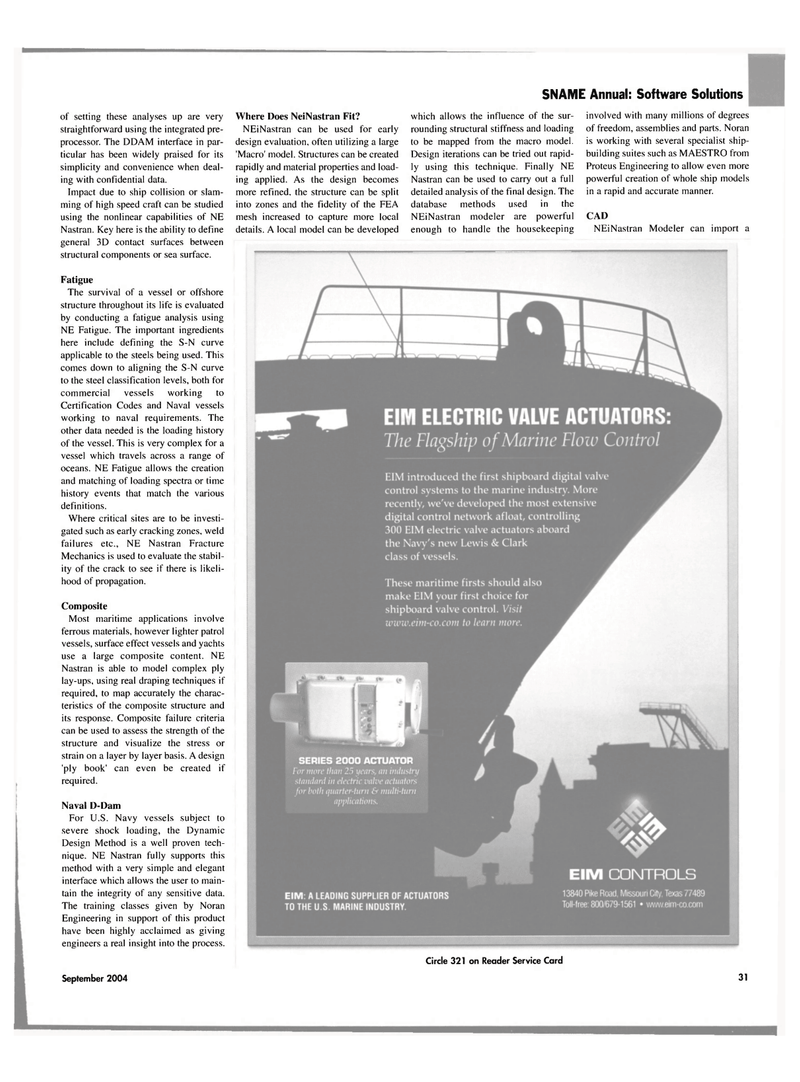
Page 32: of Maritime Reporter Magazine (September 2004)
Marine Propulsion Annual
Read this page in Pdf, Flash or Html5 edition of September 2004 Maritime Reporter Magazine
SNAME Annual: Software Solutions of setting these analyses up are very straightforward using the integrated pre- processor. The DDAM interface in par- ticular has been widely praised for its simplicity and convenience when deal- ing with confidential data.
Impact due to ship collision or slam- ming of high speed craft can be studied using the nonlinear capabilities of NE
Nastran. Key here is the ability to define general 3D contact surfaces between structural components or sea surface.
Fatigue
The survival of a vessel or offshore structure throughout its life is evaluated by conducting a fatigue analysis using
NE Fatigue. The important ingredients here include defining the S-N curve applicable to the steels being used. This comes down to aligning the S-N curve to the steel classification levels, both for commercial vessels working to
Certification Codes and Naval vessels working to naval requirements. The other data needed is the loading history of the vessel. This is very complex for a vessel which travels across a range of oceans. NE Fatigue allows the creation and matching of loading spectra or time history events that match the various definitions.
Where critical sites are to be investi- gated such as early cracking zones, weld failures etc., NE Nastran Fracture
Mechanics is used to evaluate the stabil- ity of the crack to see if there is likeli- hood of propagation.
Composite
Most maritime applications involve ferrous materials, however lighter patrol vessels, surface effect vessels and yachts use a large composite content. NE
Nastran is able to model complex ply lay-ups, using real draping techniques if required, to map accurately the charac- teristics of the composite structure and its response. Composite failure criteria can be used to assess the strength of the structure and visualize the stress or strain on a layer by layer basis. A design 'ply book' can even be created if required.
Naval D-Dam
For U.S. Navy vessels subject to severe shock loading, the Dynamic
Design Method is a well proven tech- nique. NE Nastran fully supports this method with a very simple and elegant interface which allows the user to main- tain the integrity of any sensitive data.
The training classes given by Noran
Engineering in support of this product have been highly acclaimed as giving engineers a real insight into the process.
Where Does NeiNastran Fit?
NEiNastran can be used for early design evaluation, often utilizing a large 'Macro' model. Structures can be created rapidly and material properties and load- ing applied. As the design becomes more refined, the structure can be split into zones and the fidelity of the FEA mesh increased to capture more local details. A local model can be developed which allows the influence of the sur- rounding structural stiffness and loading to be mapped from the macro model.
Design iterations can be tried out rapid- ly using this technique. Finally NE
Nastran can be used to carry out a full detailed analysis of the final design. The database methods used in the
NEiNastran modeler are powerful enough to handle the housekeeping involved with many millions of degrees of freedom, assemblies and parts. Noran is working with several specialist ship- building suites such as MAESTRO from
Proteus Engineering to allow even more powerful creation of whole ship models in a rapid and accurate manner.
CAD
NEiNastran Modeler can import a
Circle 321 on Reader Service Card
September 2004 31

 31
31

 33
33
